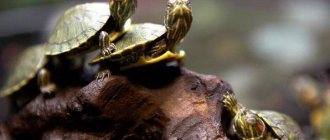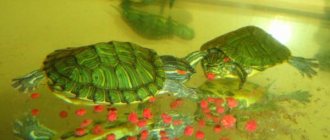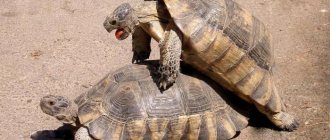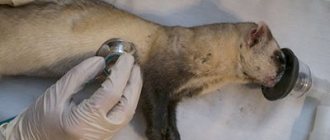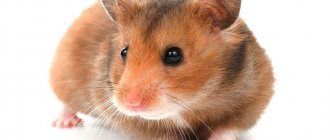- Wild animals
- >>
- Reptiles
The red-eared slider is the most popular pet amphibian in the world, which is why it became the best-selling turtle at the end of the 20th century.
This species is native to the southern United States and northern Mexico. However, it gradually began to spread to other regions due to people refusing to keep it as a pet and throwing it into local water bodies. Invasion and occupation of territories caused by careless human activities has led to problems with the fauna of many countries, as the red-eared slider displaces native species. The ruby is included in the list published by the IUCN of the 100 most invasive species.
Origin of the species and description
Photo: Red-eared turtle
Fossils indicate that turtles first appeared on earth about 200 million years ago, during the Upper Triassic period. The first known turtle was Proganochelys quenstedli. It had a fully developed shell, skull-like skull and beak. But, Proganochelys had several primitive features that modern turtles do not have.
By the mid-Jurassic period, turtles had split into two main groups: those with arched necks (pleurodire) and those with side necks (cryptodires). Modern side-necked turtles are found only in the southern hemisphere and move their heads to the side under the shell. Arch-neck turtles retract their heads in an S shape. Scutemy was one of the first arch-neck turtles.
Video: Red-eared slider
The red-eared or yellow-bellied turtle (Trachemys scripta) is a freshwater turtle belonging to the family Emydidae. It gets its name from the small red stripe around its ears and its ability to quickly glide off rocks and logs into the water. This species was previously known as Trost's turtle after American herpetologist Gerard Trost. Trachemys scripta troostii is now the scientific name of another subspecies, the Cumberland turtle.
The redfish belongs to the order Testudines, which contains about 250 species.
The species Trachemys scripta itself contains three subspecies:
- Ts elegans (red-eared);
- T.s. Scripta (yellow-bellied);
- Ts troostii (Cumberland).
The first known literary mention of redears dates back to 1553. When P. Cieza de Leone described them in the book “Chronicles of Peru”.
Famous long-lived turtles
The world-famous long-living tortoise belongs to Charles Darwin. Her name was Hariette. She was brought as a baby from the Galapagos Islands. In those days she was considered a male. They called her Harry. Its size at that time did not exceed the diameter of the saucer. She spent the last years of her life in Australia. Its weight exceeded 1.5 centners. At the time of her death, she was 177. The animal outlived its owner by 105 years.
Garietta is not the only turtle considered a legend. Another, named Advaita, according to various sources, lived 150-250 years. She belonged to the species of Giant Turtles. The British general, Robert Clywood, brought it from the Seychelles.
A radiant tortoise named Tui Malila has broken all records. She lived to be almost 200 years old. There are legends that it was once given to the leader of the natives.
Before you bring a small turtle into your home, you should understand whether it will be possible to create all the conditions for a long and comfortable life. You need to be prepared for the fact that you will have to pay attention to your pet. It is also recommended to study the features of the content and consult with specialists before purchasing.
Appearance and features
Photo: Animal red-eared turtle
The length of the shell of this type of turtle can reach 40 cm, but the average length ranges from 12.5 to 28 cm. Females are usually larger than males. Their shell is divided into two sections: the upper or dorsal carapace (carapace) + the lower, abdominal (plastron).
The upper shell consists of:
- vertebral shields, which form the central elevated part;
- pleural shields located around the vertebral shields;
- edge shields.
The scutes are bony keratin elements. The carapace is oval and flattened (especially in men). The color of the shell changes depending on the age of the turtle. The carapace usually has a dark green background with light or dark markings. In young or newly hatched specimens, this is the color of the green foliage, which gradually darkens in mature specimens. Until it turns dark green and then changes shade between brown and olive green.
The plastron is always light yellow with dark, paired, irregular markings in the center of the shields. The head, legs and tail are green with thin, irregularly shaped yellow lines. The entire shell is covered with stripes and markings that help in camouflage.
Interesting fact! The animal is a poikilotherm, that is, it cannot independently regulate its body temperature and is completely dependent on the temperature of the environment. For this reason, they need to sunbathe frequently to stay warm and maintain their body temperature.
Turtles have a complete skeletal system with partially webbed feet that help them swim. The red stripe on each side of the head distinguished the red-eared slider from other species and became part of the name, as the stripe is located behind the eyes where their (outer) ears would be.
These stripes may lose their color over time. Some individuals may have a small marking of the same color on the top of the head. In addition, they do not have a visible outer ear or external auditory canal. Instead, there is a middle ear, completely covered with a cartilaginous tympanic disc.
What kind of reptile is this?
The red-eared turtle (also known as the yellow-bellied turtle) belongs to the family of American freshwater turtles. Natural habitat is small, often swampy bodies of water with weak currents. They feed on both plant and animal foods. Distributed throughout North and South America.
The external feature is two symmetrical stripes, red, yellow or orange, located behind the eyes (on both sides of the head). The color of the dorsal part of the shell (carapace) is rich green with black and yellow lines. The lower part (plastron) is painted pale yellow with a dark pattern. The pattern from the shell extends to the skin of the paws and head, so the reptile looks striped.
Where does the red-eared turtle live?
Photo: Little red-eared turtle
Habitats are in the Mississippi River and Gulf of Mexico, as well as in the warm climate of the southeastern United States. Their home territories range from southeastern Colorado to Virginia and Florida. In the wild, red-eared turtles inhabit areas with sources of calm, warm water: ponds, lakes, swamps, streams and slow-moving rivers.
They live where they can easily get out of the water, climb onto rocks or tree trunks to warm themselves in the sun. They often sunbathe in a group or even on each other. These turtles in the wild always stay close to water unless they are searching for new habitat or laying eggs.
Due to their popularity as pets, red whales have been released or escaped into the wild in many parts of the world. Wild populations are now found in Australia, Europe, Great Britain, South Africa, the Caribbean, Israel, Bahrain, the Mariana Islands, Guam, and Southeast and Far East Asia.
An invasive species has a negative impact on the ecosystems it occupies because it has certain advantages over native inhabitants, such as a lower age at maturity and higher fertility rates. They transmit diseases and displace other turtle species with which they compete for food and breeding space.
How to extend the life of a turtle
It is not difficult to increase the time that a turtle spends next to its owner - just take care of the pet and protect it from adversity and disease. This requires very little effort:
- Spacious and roomy terrarium, equipped with a sushi island and a UV lamp.
- Regular examination of the animal to check the well-being and injuries on the body.
- Quarantine for newly arrived pets, control over the quality of food and new decorations, plants and equipment.
- Maintaining parameters of the aquatic environment, humidity and temperature in the terrarium.
- Correct and regular feeding, consisting of natural products.
Having fulfilled these requirements, you don’t have to worry that your turtle friend will soon leave the owner. Red-eared turtles are charming and funny creatures that can stay close to their owners for a long time, bringing peace and tranquility.
However, the life of pets can be cut short at any time due to the fault of the owner, so it is important to properly organize the conditions for turtles in captivity, showing care and respect for the silent friend
What does the red-eared slider eat?
Photo: Red-eared turtle boy
The red-eared slider has an omnivorous diet. They need abundant aquatic vegetation, as this is the main food of adults. Turtles do not have teeth, but instead have jagged and sharp horny ridges on their upper and lower jaws.
The animal's menu includes:
- aquatic insects;
- worms;
- crickets;
- snails;
- small fish,
- frog eggs,
- tadpoles,
- water snakes,
- various algae.
Adults tend to be more herbivorous than juveniles. When young, the red-eared turtle is a predator, feeding on insects, worms, tadpoles, small fish and even carrion. Adults are more inclined to a vegetarian diet, but do not refuse meat if they can get it.
Interesting fact! Sex in turtles is determined during the embryogenesis phase and depends on the incubation temperature. These reptiles lack sex chromosomes that determine sex. Eggs that are incubated at 22 - 27°C become only males, and eggs that are incubated at higher temperatures become females.
These reptiles are highly adaptable to their environment and can adapt to anything from brackish waters to man-made canals and urban ponds. The red-eared slider can wander away from water and survive cold winters. Once available habitat is found, the species quickly colonizes the new area.
Rules for keeping at home
The main rule for keeping a turtle at home is to provide it with living conditions that are as close to natural as possible.
To feel good, one turtle needs an aquarium with a volume of one hundred and fifty liters. The aquarium should not only have water, but also dry land so that the pet can sometimes walk, rest and bask on a hard surface. Dry land should occupy 1/3 of the volume of water in the aquarium. Pet stores sell special islands for turtles; among them, you can choose one of a suitable size and place it in the aquarium.
Don’t try to save money and build islands yourself. It will be difficult for the turtle to climb onto the slippery bottoms of plastic bottles and other debris that represent land. This will spoil the animal’s mood and will also lead to a refusal to walk, which will certainly affect the pet’s health and well-being.
Turtles love warmth very much, so the aquarium should always be maintained at the same temperature. Special lamps for terrariums will help you with this. Drafts and cold are dangerous for handsome red-eared cats; they can catch a cold and get sick. Therefore, you need to protect them from strong temperature changes.
Periodically you will have to change the water and clean the aquarium. You don’t need to do this more than once a week, but you shouldn’t wait too long between cleaning your turtle house.
Feeding
Nutrition is a very important aspect in caring for red-eared turtles. With the right diet, your pet will live at home for at least thirty years. After all, balanced food is the key to a long life for your pet.
Feeding the turtle should be done during the day, as it is a diurnal animal. The basis of a turtle's diet at home is special dry food. It can be purchased at any veterinary pharmacy or pet supply stores.
Dry food alone will seem like too little nutrition for your turtle. In order to replenish the required amount of protein, you should diversify the animal's diet.
Foods containing proteins needed in the red-eared slider's diet:
- Meat: chicken, beef, rabbit, turkey. It shouldn't be greasy. Boiled or raw, always thinly sliced.
- Insects: bloodworms, earthworms. They are needed so that the turtle’s body perceives its diet as natural.
- Fruits, vegetables, various plants.
- Gamarus and snails. Gamarus are aquatic crustaceans; when alive, they are the healthiest food for a turtle. You can buy them all year round.
- Seafood.
Turtles also need a variety of mineral and vitamin supplements. They compensate for the lack of microelements, and also improve the well-being and appearance of the pet.
The most necessary elements:
- Vitamin D - once a week.
- Vitamin A - once every two weeks.
They should be given in oil form and added to food.
How to determine the sex of a red-eared turtle
To determine the sex of your turtle, carefully examine them from all sides. Males have thicker and longer claws on their paws than females. In turn, females are the owners of graceful thin, short tails. Males' tails, on the contrary, are long and wide at the base.
Features of character and lifestyle
Photo: Large red-eared turtle
Red-eared turtles live from 20 to 30 years, but can live more than 40 years. The quality of their habitat has a strong influence on life expectancy and well-being. Turtles spend almost all their time in the water, but since they are cold-blooded reptiles, they leave the water to sunbathe in order to regulate their body temperature. They absorb heat more efficiently when their limbs are extended outward.
Red whales do not hibernate, but plunge into a kind of suspended animation. When turtles become less active, they sometimes come to the surface for food or air. In the wild, turtles spend the winter at the bottom of ponds or shallow lakes. They generally become inactive in October when temperatures drop below 10°C.
During this time, turtles enter a state of stupor, during which they do not eat or defecate, remain almost motionless, and their breathing rate drops. Individuals are most often found underwater, but have also been found under rocks, in hollow stumps and sloping banks. In warmer climates, they can become active in winter and come to the surface to swim. When the temperature begins to drop, they quickly return to a state of stupor.
On a note! Red-eared turtles are caught for food from early March to late April.
During brumation, the species can survive anaerobically (without air) for several weeks. The turtles' metabolic rate drops sharply during this time, and heart rate and cardiac output are reduced by 80% to minimize energy requirements.
Social structure and reproduction
Photo: Red-eared turtle
Male turtles reach sexual maturity when their shell is 10 cm in diameter, and female turtles are mature when their shell is 15 cm in diameter. Both males and females are ready to reproduce at the age of five to six years. The male is smaller than the female, although this parameter is sometimes difficult to apply since the individuals being compared may be of different ages.
Courtship and mating take place underwater from March to July. During courtship, the male swims around the female, directing his pheromones towards her. The female begins to swim towards the male and, if she is receptive, sinks to the bottom to mate. Courtship lasts about 45 minutes, but mating takes only 10 minutes.
The female lays between two and 30 eggs depending on body size and other factors. Moreover, one individual can lay up to five clutches in one year, with time intervals of 12-36 days.
Interesting fact! Fertilization of the egg occurs during oviposition. This process allows fertilized eggs to be laid in the next season, since the sperm remains viable and available in the female’s body even in the absence of mating.
In the last weeks of pregnancy, the female spends less time in the water and looks for a suitable place to lay eggs. She digs a hole-nest using her hind legs.
Incubation takes from 59 to 112 days. The offspring remain inside the eggshell for two days after hatching. During the first days, the cubs still feed from the yolk sac, the reserve of which still remains in the egg. The area through which the yolk is absorbed must heal on its own before the turtles can swim. The time between hatching and immersion in water is 21 days.
Reliable determination of a pet's age
It is not difficult for a specialist to determine its age just by looking at a reptile. But what should inexperienced owners do when they get such an unusual pet? You can use several methods - measure the length of the carapace, evaluate the nature of its pattern, the shape and color of the shield.
Method I
It's not 100% correct, but it's still worth a look because it's fairly easy to do.
Initially, it is important to find out whether the turtle is male or female, which is not so easy to do, especially if we are talking about a young individual. And only after this can you measure the diameter of the reptile’s shell and compare the data obtained with basic information:
- in the first year of life, the size of the carapace in red whales is 6 cm, regardless of gender;
- in the second year of life, the diameter of the armored shield of females increases to 9 cm, of males - to 8 cm;
- by the 3rd year, the carapace of females grows to 13-14 cm, and in males its length does not exceed 10 cm;
- in the 4th year, the size of the shell of males and females increases on average by 2 cm;
- in 5-year-old individuals, the length of the carapace is 18 cm in the case of a female, and 14 cm in males;
- at 6 years, the female’s shield increases by 2 cm, the male’s by 3 cm.
When a reptile reaches 6 years of age, its shell grows to its maximum size, and subsequently its diameter remains practically unchanged. Even if this happens, the increase is insignificant, and gradually the growth stops completely. The size of the carapace of a red-eared turtle is associated with the following factors:
- variety of diet;
- the size of the aquaterrarium;
- living conditions;
- the absence of hibernation or the presence of this period.
If you take into account such nuances, it is easy to understand that errors, often quite significant, cannot be avoided in calculations. Having obtained data in this way, you can correct the result using another technique - the most reliable.
II method
This method is based on determining the age of a reptile from the image on its carapace. Experts consider a turtle's shell to be its individual identifier, comparing it to a human fingerprint.
If the turtle eats well and lives in suitable conditions, then the shield pattern will be unique. But when a reptile lives in an unsuitable environment, is injured, becomes dry, or experiences other difficulties, its scutes can become deformed and peel off, which negatively affects the pattern.
There are a number of concentric rings on the shell that indicate its age. They appear in individuals after the first year of life, and then become intense during the 2nd and 3rd years. Every 6 months there are 2-3 more rings, after which the process slows down, and then only one ring appears per year.
If you count the number of rings, it is easy to find out how old the four-legged swimming pet is. Even if he came to a new home already as a large, adult individual. To get an accurate figure, you need to count the rings and take the average result. And in this case, some discrepancy with reality is possible.
III method
This method is based on assessing the color of the carapace - the intensity of the shade changes with age. The younger the individual, the lighter and calmer the color of its shell. After 4 years his tone becomes darker. Older red-eared turtles have an almost black shield, and this also applies to the rings.
As the reptile matures, the carapace becomes regular, oval in shape, and its surface becomes smooth, which is not the case in young animals. Young turtles are more active, energetic and inquisitive, they move more and climb everywhere. Old individuals are sedentary and phlegmatic; they can often be found resting. But such signs are observed not only in turtles, but also in other creatures - old age manifests itself in the same way in almost everyone.
It is worth noting that if the pet was purchased when it was still small, then there is no particular need to calculate its exact age. The main thing is to distinguish between the needs of young, adult and elderly reptiles and provide suitable food and amenities. But, regardless of age, the red ear needs clean water, ultraviolet rays, warmth and maintaining certain parameters of both water and air. This is the key to a healthy, long and fulfilling life for your pet.
Natural enemies of the red-eared slider
Photo: Adult red-eared turtle
Due to its size, bite and thickness of shell, an adult red-eared turtle should not be afraid of predators, of course, unless there are alligators or crocodiles nearby. She can retract her head and limbs into her shell when threatened. In addition, red whales monitor predators and seek refuge in the water at the first sign of danger.
However, this does not apply to juveniles, which are preyed upon by a variety of predators, including:
- raccoons;
- skunks;
- foxes;
- wading birds;
- storks.
Raccoon, skunk and fox also steal eggs from this turtle species. Juveniles have unusual defenses against predatory fish. When swallowed whole, they hold their breath and chew the mucous membrane inside the fish until the fish regurgitates them. The bright colors of small predators warn large fish to avoid them.
In their home range, red-eared turtles occupy an important ecological niche both as food and as a predator. Outside their habitats, they fill the same types of niches and become an important food source for predators in urban and suburban areas.
Due to their adaptability, red-eared turtles are the predominant turtle species in urban environments. Most parks in many cities in the United States have thriving colonies of red-eared turtles for people to enjoy.
Causes of premature death
The most common causes of death of pets are:
- Improper conditions of detention. Small aquarium, dirty unfiltered water, untimely cleaning, inappropriate temperature conditions.
- Infections. They can appear from aquarium plants, decorative elements, and live food.
- Poor nutrition and lack of vitamins. In nature, a turtle can compensate for the deficiency of any element on its own; when kept at home, monitoring the diet is the owner’s task.
- Lack of qualified veterinary specialists who can correctly and timely diagnose health problems and prescribe adequate treatment.
